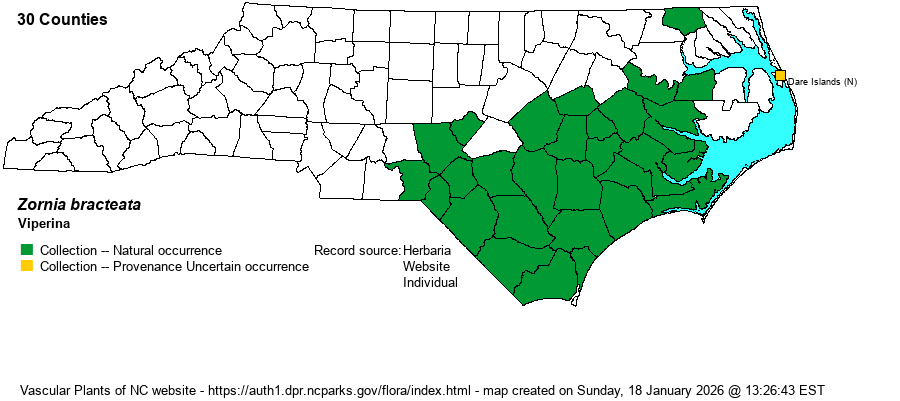| Author | Walter ex J.F. Gmelin | |
| Distribution | Throughout the southern 50-60% of the Coastal Plain, including the Sandhills region. Recorded from Gates County, but no other known records from the northern part of the province, including the far eastern counties (except for Roanoke Island in Dare County).
This is a Southern Coastal Plain species, ranging north to southeastern VA, south to southern FL, and west to TX. | |
| Abundance | Fairly common in the Sandhills and in the lower Coastal Plain, but mostly infrequent in the middle parts of the range. Not as numerous as would be expected from the range map, though it is widespread in occurrence. | |
| Habitat | This low-growing plant is found mostly in sandy soil, but generally in disturbed situations rather than in pristine natural areas. It grows on sandy roadsides, lawns, and various other types of clearings. It can be found in pine/scrub oak sandhills and pine flatwoods, but usually where there are bare patches of sand where there is very little other plant competition, such as margins of trails. | |
| Phenology | Blooms from June to August, and fruits from July to October. | |
| Identification | This is a rather bizarre yet pleasantly unique plant in NC. It has several stems from a node, and these are slender and trailing, generally 1-2 feet long. It has scattered leaves, each divided into 4 leaflets, each very slender and collectively forming a cross like a bird's foot. Each leaflet is about 3/4-inch long and essentially linear, dark green and evergreen-looking. The flowers are in short spikes of a few flowers, but yet on stalks a few inches long, often raised quite upright. The deep golden-yellow flowers, each about 1/2-inch long, are almost enclosed by two wide leafy bracts. Experienced observers can easily identify this "mini-vine" by its unique "4-toed" leaf, but as the plant grows along the ground, often in lawns and on roadsides, some people will literally walk on top of these plants without noticing them! When the golden-yellow flowers are visible, some folks will simply call it a "pencil-flower" (Stylosanthes biflora) and pass on. But, you really should get down on your knees and appreciate this wonderful plant. As mentioned above, it is surprisingly difficult to find this plant in well-maintained natural areas, and it seems to thrive in places that get frequently mowed -- roadsides and lawns, as owing to its very low stature it seemingly avoids getting mowed more so than other, taller plants. | |
| Taxonomic Comments | None
| |
| Other Common Name(s) | None. Oddly, many websites and references simply give no common name for the species, implying a common name of "Zornia". | |
| State Rank | S3? [S4] | |
| Global Rank | G5? | |
| State Status | | |
| US Status | | |
| USACE-agcp | | |
| USACE-emp | | |

